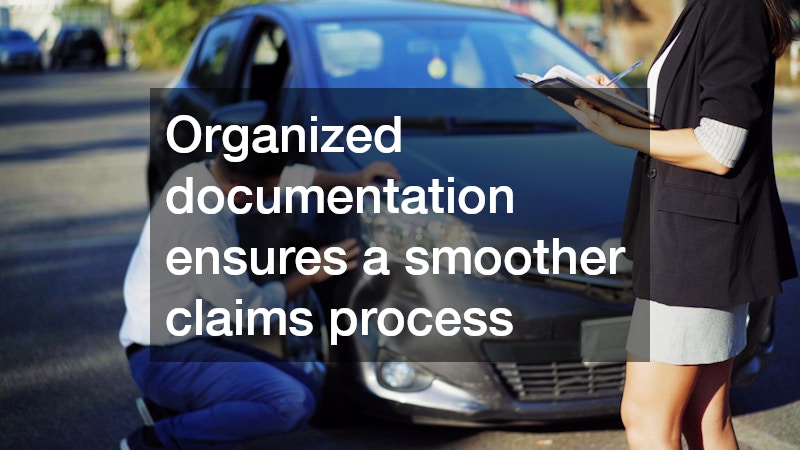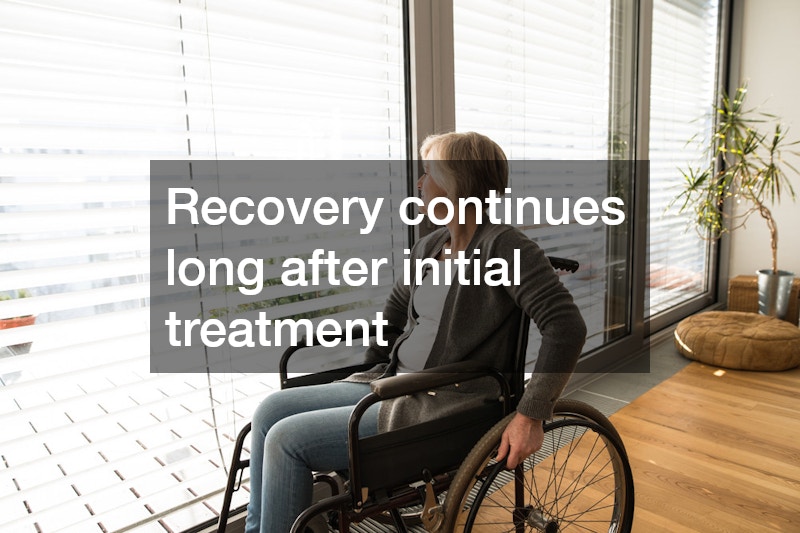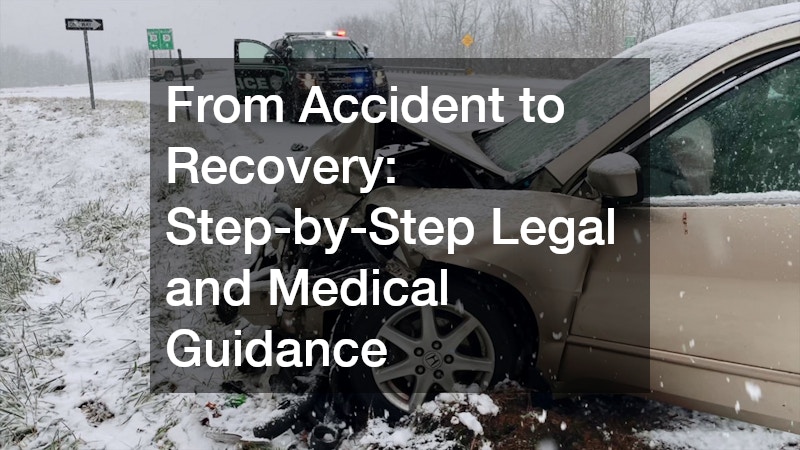
Experiencing a car accident can be overwhelming, both physically and emotionally. Between navigating medical care, managing vehicle repairs, and understanding your legal rights, it’s easy to feel lost. However, having a structured plan can help you address immediate needs, prevent long-term complications, and protect your rights. This guide provides a comprehensive timeline from the moment of impact to full recovery, covering medical evaluations, legal support, vehicle documentation, and ongoing rehabilitation.
Immediate Steps After a Collision
The first hours following an accident are crucial for safety and documentation. Acting methodically can protect your health and support any potential legal claim.
-
Ensure safety first: Move yourself and passengers out of traffic if possible. Use hazard lights, cones, or flares to warn oncoming drivers.
-
Check for injuries: Even minor accidents can result in hidden injuries. Pay attention to head, neck, and back pain, as well as bleeding or swelling.
-
Call emergency services: Dial 911 for serious injuries or if the accident blocks traffic. Emergency responders document the scene and can provide immediate care.
Key Actions to Take
-
Contact an auto accident lawyer as soon as possible to understand your rights, preserve evidence, and begin insurance coordination. Early consultation ensures critical documentation is collected correctly.
-
Visit the emergency room even if injuries appear minor. Medical records from the ER are crucial evidence for both insurance claims and legal cases.
-
Document the scene with photos of vehicles, license plates, traffic conditions, and any visible injuries. Collect contact information from witnesses.
By handling these initial steps promptly, you protect both your physical well-being and legal standing.
Vehicle Recovery and Documentation
Once immediate safety and medical concerns are addressed, it’s crucial to focus on your vehicle. Proper management of vehicle recovery, repair, and documentation not only ensures your car is restored safely but also protects your legal and insurance interests.
Arranging Vehicle Transport
-
Contact local towing companies promptly to transport the vehicle to a secure storage area or certified repair shop.
-
Choose towing providers with experience handling accident vehicles, especially if your car has structural damage or is a modern model with electronic systems.
-
Consider whether flatbed towing is necessary to prevent additional damage, particularly for cars with all-wheel drive, low clearance, or extensive undercarriage damage.
-
Confirm insurance coverage for towing services; many policies include towing reimbursement, which should be documented for claims purposes.
Selecting a Collision Repair Shop
-
Research and select a reputable collision repair shop with certified technicians, positive reviews, and experience with your vehicle make and model.
-
Ensure the shop can provide a comprehensive repair plan, including both visible and hidden damage such as frame misalignment, airbag systems, and electronic components.
-
Request an initial estimate and a timeline for repairs. Verify whether the shop will coordinate with your insurance adjuster for streamlined claim processing.
-
Ask for documentation of all repairs performed, including parts replaced, labor hours, and warranty information for work completed.

Tips for Vehicle Documentation
-
Take detailed photographs of all visible damage before the vehicle is towed or repaired. Include wide-angle shots of the entire car and close-ups of dents, scratches, cracked glass, and broken components.
-
Maintain a digital folder of all repair estimates, invoices, and communication with repair shops. Include email exchanges, photos of completed work, and signed agreements.
-
If you require a rental vehicle, keep records of rental agreements, mileage, fuel receipts, and associated expenses for potential reimbursement from insurance claims.
-
Track any additional costs incurred due to delayed repairs, such as transportation or missed work, as these may be claimable.
Best Practices for Organized Documentation
-
Create a chronological record of all events related to your vehicle after the accident, including towing, inspection, repair milestones, and final pickup.
-
Label all files and photographs clearly with dates and descriptions to make the documentation easy to reference for insurance claims or legal proceedings.
-
Retain copies of all documents for future reference, even after repairs are completed, to protect against delayed damage claims or insurance disputes.
By combining careful selection of professional services with meticulous documentation, you ensure your vehicle is repaired safely while strengthening your legal and insurance position. Organized records reduce delays, prevent misunderstandings, and provide clear evidence if disputes arise.
Diagnostic Assessments and Vehicle Inspections
Modern vehicles often have hidden damage that isn’t immediately visible. Conducting thorough diagnostics ensures safety and supports legal claims.
-
Engage auto diagnostic services to inspect electrical systems, engine components, and electronic safety features. These services detect issues that might otherwise be overlooked.
-
Coordinate findings with your collision repair shop to ensure all necessary repairs are performed before accepting the vehicle back.
Actionable Steps
-
Request detailed diagnostic reports and photographs for your records.
-
Keep a timeline of diagnostics, repairs, and follow-up inspections to support legal or insurance documentation.
-
Communicate with your lawyer about any hidden or recurring vehicle issues that could impact claims.
Proper diagnostics prevent safety risks and provide an accurate record for claims or legal proceedings.
Medical Follow-Up and Recovery Planning
Recovering from a car accident is a process that extends far beyond initial treatment. Proper follow-up care is essential not only to restore function but also to prevent long-term complications and ensure that all injuries—visible or hidden—are addressed. Establishing a structured recovery plan and maintaining consistent communication with healthcare providers is key to achieving optimal outcomes.
Physical Rehabilitation
-
Schedule physical rehabilitation promptly if injuries involve muscles, joints, or the spine. Even minor strains can worsen without proper therapy.
-
Develop a personalized therapy plan with your physical therapist that targets flexibility, strength, and balance. For example:
-
Mobility exercises for regaining full joint range of motion.
-
Strengthening routines to support weakened muscles post-trauma.
-
Balance and coordination drills to reduce the risk of secondary falls or injuries.
-
-
Progressively adjust therapy intensity based on improvement, ensuring that patients do not overexert injured areas, which could delay recovery.
-
Integrate at-home exercises alongside in-clinic sessions to reinforce gains and maintain consistency. Clear written or video instructions from the therapist can help maintain correct form.
Auditory and Sensory Assessments
-
Conduct a hearing test after any accident involving head trauma, whiplash, or exposure to loud crash noises. Symptoms of hearing loss may not appear immediately, so periodic testing is recommended.
-
Early identification of hearing changes allows timely interventions, including hearing aids, auditory therapy, or medical treatments that prevent permanent damage.
-
Record test results to track progress over time and share with your healthcare team to adjust treatment strategies.
Practical Recovery Tips
-
Maintain a detailed log of therapy sessions, pain levels, mobility limitations, and any new symptoms. This log serves as a useful reference for healthcare providers, legal documentation, and insurance claims.
-
Set clear milestones with your therapist, such as regaining a specific range of motion, completing daily activities without assistance, or returning to work duties. Monitor progress against these goals and adjust treatment as necessary.
-
Incorporate lifestyle adjustments recommended by healthcare professionals, such as ergonomic modifications, posture corrections, or assistive devices, to support recovery and prevent secondary injuries.
-
Schedule regular check-ins with your primary physician or specialist to review overall recovery progress, reassess therapy plans, and identify any complications early.
Documentation for Legal and Insurance Purposes
-
Keep all medical records organized, including clinic notes, therapy reports, diagnostic test results, and hearing assessments.
-
Document any prescriptions, over-the-counter treatments, or medical devices used during recovery.
-
Share these records with your auto accident lawyer and any supporting legal nurse consultant to ensure that ongoing medical care is accurately reflected in claims.
Maximizing Recovery Outcomes
-
Combine professional care with personal diligence: follow therapy recommendations, adhere to exercise schedules, and maintain proper nutrition and rest to support healing.
-
Monitor symptoms continuously and report any persistent pain, dizziness, or hearing changes to your healthcare team promptly.
-
Adjust therapy intensity gradually and avoid rushing recovery to prevent reinjury.
Consistent follow-up care, structured rehabilitation, and careful documentation not only improve long-term health outcomes but also provide critical support for legal claims and insurance settlements. By approaching recovery with both medical and practical planning, patients can regain independence safely and efficiently.
Dental Care After a Crash
Car accidents often result in facial injuries, including broken teeth, jaw trauma, and soft tissue damage. Prompt dental care is important both for health and legal documentation.
-
Utilize cosmetic dentistry services for repairing visible damage, restoring function, and improving aesthetics.
-
Consider dental implants for missing teeth or severe damage. Implants provide long-term solutions and help maintain oral health.
Recommendations for Dental Recovery
-
Document all dental procedures, including photographs and receipts.
-
Maintain follow-up appointments to monitor healing and address complications early.
-
Communicate with your auto accident lawyer about dental injuries to ensure they are included in your compensation claim.
Addressing dental issues promptly not only improves health outcomes but also strengthens your legal position.
Legal Case Support and Expert Consultation
Medical documentation alone may not be enough to maximize compensation. Expert legal support ensures your case is handled effectively.
-
A legal nurse consultant can review medical records, rehabilitation notes, and dental treatment plans to verify injuries and assist in building your case.
-
An auto accident lawyer coordinates between healthcare providers, repair shops, and insurance companies to ensure claims are accurate and timely.
How to Maximize Legal Support
-
Provide your lawyer and nurse consultant with a comprehensive packet of all medical, dental, and repair documentation.
-
Communicate regularly to update on recovery progress, new symptoms, or additional treatments.
-
Keep organized copies of all correspondence with medical providers, repair services, and insurance adjusters.
Collaboration between legal and medical experts helps protect your rights and optimize settlement outcomes.
Organizing Documentation and Insurance Claims
Well-organized documentation makes the difference between a smooth claim process and unnecessary delays.
-
Consolidate records from local towing companies, collision repair shops, and auto diagnostic services.
-
Maintain copies of medical reports, rehabilitation notes, hearing tests, and dental treatment plans (cosmetic dentistry services, dental implants).
Tips for Claim Efficiency
-
Create a dedicated digital folder for all documents, accessible to your lawyer and consultants.
-
Keep a chronological timeline of events from the accident through recovery.
-
Maintain receipts for rental cars, prescriptions, therapy sessions, and other expenses to support reimbursement claims.
Organized documentation streamlines communication with insurers and strengthens your legal case.
Coordinating Ongoing Recovery and Monitoring Progress
Recovery after a car accident is a gradual process that extends well beyond initial medical treatment. Even when injuries appear minor, delayed symptoms or complications can arise. Maintaining a structured approach to ongoing recovery helps ensure full rehabilitation, prevents setbacks, and supports legal or insurance claims if new issues emerge.
Scheduled Rehabilitation and Health Check-Ins
-
Continue physical rehabilitation with a consistent schedule tailored to your injury type. For example, musculoskeletal injuries may require multiple sessions per week initially, tapering as strength and mobility improve.
-
Reassess therapy goals regularly with your therapist to ensure progress aligns with functional recovery milestones, such as regaining range of motion, balance, or endurance.
-
Conduct periodic hearing tests if head trauma, whiplash, or exposure to loud collision sounds occurred. Early detection of hearing changes allows prompt treatment and prevents long-term auditory complications.
Tracking Progress and Milestones
-
Maintain a recovery log noting measurable improvements, including reduced pain, increased flexibility, improved gait, or better hearing scores.
-
Use charts or journals to visualize progress over time; this helps both your healthcare providers and legal team monitor recovery.
-
Record side effects, flare-ups, or new symptoms, even if they seem minor, to ensure they are addressed promptly.
Adjusting Therapy and Treatment
-
Collaborate with your healthcare team to modify therapy or medical interventions as recovery progresses. For instance, gradually increasing exercise intensity in physical rehabilitation or adjusting hearing therapy protocols.
-
Incorporate home exercises or assistive devices recommended by therapists to reinforce in-clinic treatments and prevent regression.
-
Regularly review pain management strategies to avoid long-term reliance on medications while maintaining functional mobility.
Legal and Documentation Considerations
-
Keep your auto accident lawyer informed about any setbacks, persistent symptoms, or new medical findings. Accurate documentation of ongoing recovery is critical for potential claim adjustments.
-
Share updated medical records, therapy notes, and test results with your lawyer and any legal nurse consultant supporting your case.
-
Document all follow-up appointments, procedures, and communications to maintain a complete record for insurance and legal purposes.
Preventing Long-Term Complications
-
Consistent monitoring allows early intervention for complications such as joint stiffness, delayed hearing loss, or post-traumatic injuries.
-
Schedule regular check-ups even after initial recovery milestones are met to ensure sustained health and functionality.
-
Incorporate lifestyle adjustments recommended by healthcare professionals, such as ergonomic modifications, exercise routines, or hearing protection, to support long-term recovery.
By systematically coordinating ongoing rehabilitation, monitoring progress, and documenting changes, individuals can optimize recovery outcomes, prevent secondary injuries, and provide clear evidence for any ongoing legal or insurance needs.

Additional Considerations for Legal and Medical Coordination
A proactive approach combines medical, dental, and vehicle documentation to strengthen legal claims and facilitate full recovery.
-
Schedule all follow-ups in coordination with your legal team to ensure claims remain accurate and comprehensive.
-
Keep communication open among healthcare providers, repair shops, and legal professionals.
-
Document any out-of-pocket expenses and additional care required during recovery for reimbursement purposes.
A coordinated approach ensures nothing is overlooked, maximizing both health outcomes and compensation.
Recovering from a car accident involves much more than healing—it requires careful coordination of medical care, legal support, and vehicle repairs. By following a structured timeline, including prompt medical attention, vehicle documentation, rehabilitation, dental care, and expert legal consultation, you can protect your health, your rights, and your financial interests.
Taking proactive steps and maintaining detailed records throughout the process ensures a smoother, safer recovery while strengthening your legal position. With proper planning and support, the path from accident to full recovery becomes manageable and organized.



